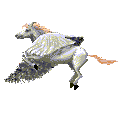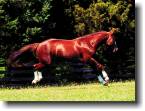![]() to...
to...
Winding Creek Stable's: Arabian Horse Page

CAUTION!
The Versatile Arabian Horse
People love, admire and depend upon Arabian horses for their superior versatility and athleticism today, just as they have since 400 B.C. Ancient Bedouin tribesmen of the Middle East put their loyal mounts to the ultimate athletic tests as beasts of burden and a means of transportation. As encampments moved, Arabian horses carried heavy loads over miles of hot desert sand with little food or water. Often quieter than stallions, mares served as war horses, allowing their masters to sneak up on the enemy during tribal raids. These animals were cherished, honored and loved. So crucial were Arabian horses to the Bedouin way of life, they often slept in the family tent on chilly nights. Arabian horses returned the love to their masters, developing an intense protective loyalty and willingness to please. Centuries of close interdependence with man brought forth this horse with sensitivity, intelligence and an ability to bond with humans.
The Arabian has the distinction of being the oldest living breed of horse. Equus Agilis, one of the four original species of horse has been identified in modern times as the Arabian horse. While other breeds disappeared or were mixed with different breeds, the Arabian remained essentially the same. Although the first recorded history of the horse was from 3,000 years ago, some archaeologists believe the breed existed as long as 40,000 years ago. Arabian horses made their debut in America during the 1893 Chicago World's Fair, where Bedouins exhibited 29 horses. The breed gradually grew, but it wasn't until the 1940's that Arabians gained widespread popularity through the advent of horse shows.
Beauty Meets Athleticism
The Arabian horse is known for its elegant features. Its dished head, large eyes, arched neck and high tail carriage precede its reputation as the most beautiful of all breeds. "A neck curved like a crescent moon and a nose that could fit into a teacup" is an old Arab expression used to describe this look. However, this refinement is more than just cosmetic.The Arabian's natural physical characteristics aid outstanding performance in today's equine activities. The short, dished head and wide, flaring nostrils allow for maximum oxygen intake. The arched neck keeps the windpipe defined and clear to carry air to the lungs. There's plenty of room for lung expansion because of well-sprung ribs and a deep chest cavity. Through careful breeding, strong, resilient legs are free of most lameness problems more common in other breeds. Some scientists believe the Arabian horse has one less vertebra in its back, allowing it to carry greater weight. Such qualities give the Arabian horse superior athleticism and versatility. Arabians can excel in any activity that people enjoy doing with horses.
Genetic Strength That Lasts
The Arabian traits coveted for thousands of years still endure, greatly due to the Bedouins careful breeding and recording of bloodlines. Since the bloodlines have remained so pure and have been carefully cultivated over the years, a strong genetic stability, known as prepotency has resulted. This ability to pass on traits allows Arabian qualities such as beauty, intelligence, endurance and temperament to become quite evident in crosses with other breeds. For thousands of years, people bred Arabian horses to their own stock to pick up the famous Arabian qualities. In fact, the Arabian horse is the genetic predecessor of every light horse breed in existence today. A special modern breed of horse known as the Half-Arabian developed through Arabian crosses.To be registerable, Half-Arabians must have one registered, purebred Arabian parent and one parent of any other breed or mixed breed. For instance, when the Quarter Horse, known for western and stock horse events, is bred to the Arabian, it can pick up added quickness and agility. The Saddlebred crossed with the Arabian often produces an animated, high-stepping show horse. The one Arabian cross that is recognized as a separate breed is the Anglo-Arabian. A registerable Anglo-Arabian horse may be any combination of Thoroughbred and Arabian blood, provided there is no more than 75 percent and no less that 25 percent Arabian blood. The breed is popular, particularly in Europe, because of its aptitude for events such as hunter/jumper and dressage. In 1990, the Anglo-Arabian Morgat led the French Olympic Team to a gold medal at the Stockholm Show Jumping World Championships.
The Horse For All Uses
Arabians constitute a large majority of the top horses in one of the fastest growing equine sports, distance riding. Becky Hart's purebred Arabian R.O. Grand Sultan is an example of the consummate distance racer. Better known as Rio, one of his biggest accomplishments was winning a gold medal at the 1992 Endurance Ride World Championships in Barcelona, Spain. The horses that made the silver medal winning U.S. Endurance team were all Arabians and one Half-Arabian. Hart and Rio also won a gold medal at the 1990 World Equestrian Games in Stockholm, Sweden. This dramatic performance brought home the only North American gold medal of any breed.The Arabian breeds also demonstrate versatility in the show ring. At a typical Arabian horse show, you can watch these horses giving a smooth, enjoyable ride in Western, English or country English pleasure, executing complicated trail tests; digging in the dirt with cattle; cunningly navigating hunter and jumping courses; and exuding brilliance and animation in a park class. One of the most popular events at an Arabian horse show is the native costume class. Audiences are captivated by the horses and riders parading around the ring in the beautifully-crafted, elaborate native Arabian costumes. Arabian horses also command the attention of cutting, reining and stock horse riders. Many ranchers are discovering that the intelligent Arabian makes a resourceful and agile work horse. With more than 150 horses, Rush Creek Ranch in Nebraska exclusively uses Arabians for strenuous work on their large cattle ranch.
Arabians are also gaining recognition in the most competitive dressage circles. Arabian EA Novette+ has been named United States Dressage Federation (USDF) Horse of the Year twice in the last three years at AHSA 5th Level Test 3 and AHSA International I Level. Novette and rider Sandi Chohany competed against all breeds all over the United States to win the awards. "Novette won with a score of 63.077. That's an excellent score for such a high level," said Martha Worcester, USDF Director of Information. "She's really helping to make a name for the Arabians in dressage."
One of the fastest growing segments of the Arabian Horse industry is racing. Often referred to as "drinkers of the wind," the Arabian breed naturally loves racing. It's also evident that racetracks and the betting public love Arabian racing. The number of races available for Arabians today is ten times what it was 13 years ago, and the purses offered have grown from $64,000 in 1979 to $3,630,000 in 1992.
Prestigious Shows and Programs
The organization that coordinates and approves Arabian horse shows, events and award programs is the International Arabian Horse Association (IAHA). Opportunities for competition abound in all-Arabian as well as open events at all skill levels.IAHA comprises 18 regions across the United States and Canada, each offering an annual regional show. IAHA sponsors other major shows including the Youth National Championship, U.S. National Championship, Canadian National Championship, Youth Judging Contest, U.S. Futurity/Maturity Championship and national championships in competitive trail and endurance riding. IAHA also offers high-stakes prize money payback and awards programs to recognize the accomplishments of Arabian horses and their owners.
Protecting The Heritage
The best way to protect the heritage of the Arabian and keep the bloodlines pure is through registration. AHRA handles registrations and transfers of ownership for all purebred Arabians in the United States, Canada and Mexico. To date, owners have registered more than 434,000 Arabian horses. IAHA is responsible for registrations and transfers of ownership for all Half-Arabian and Anglo-Arabian horses. These horses are almost as popular as purebreds, with close to 300,000 registered to date.The Arabian horse has a long and dramatic history. But the future of this proud breed grows even brighter as more people discover the athletic prowess and capabilities of this versatile horse.
by Rachelle Kostel - IAHA Public Relations Division

Photo Gallery } Characteristics } History-Horse of the Desert Bedouin-Orgin of the Arabian horse-Arab horses spread to Europe-Introduction of the Arabian horse to North America-Arabians in the U.S. Army-The Arabian horse today } Profile } Arab Links } Arabian horse Activities } Ownership & Care } Equine Humor } Free Horse Clipart } Candid Camera } My Arab's Page } Tack } Genes } Drinkers Of The Wind
Questions?
Comments? Or do you see a picture of your's on here you would
like taken off? Please ![]()
This Page Has Been Jumped  <img border="0"
<img border="0"
src="http://fastcounter.linkexchange.com/fastcounter?1082946+2165899">